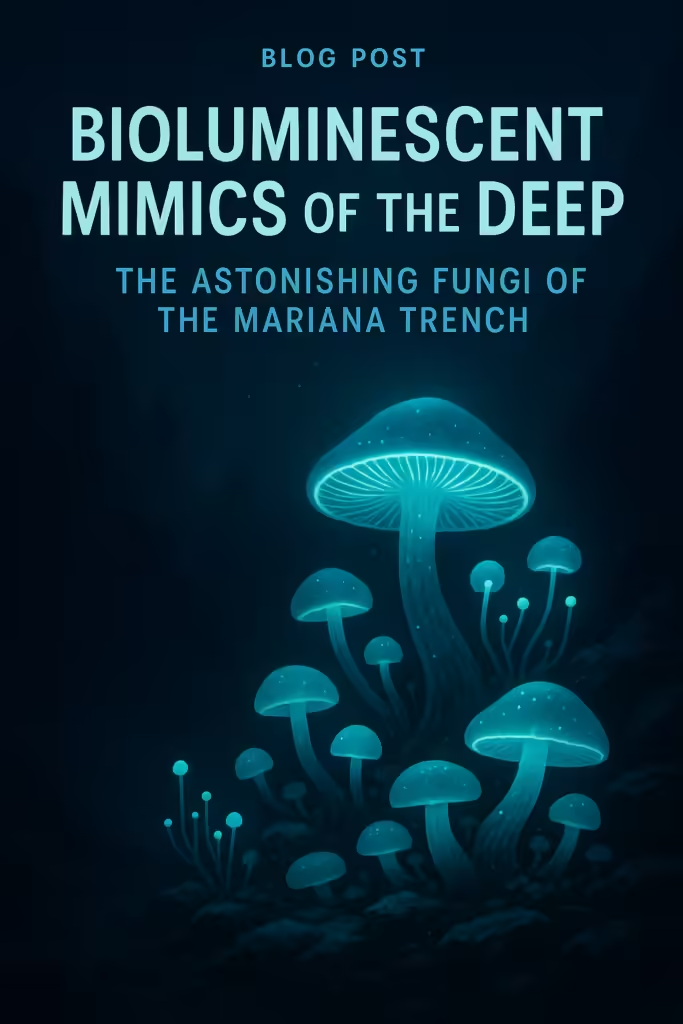
Bioluminescent Mimics of the Deep: The Astonishing Fungi of the Mariana Trench
In the crushing darkness of the world’s deepest ocean trench, where sunlight has never touched and pressures exceed 1,000 times what we experience at sea level, life finds a way—not just to survive, but to dazzle. Recent discoveries have turned scientific attention toward an unassuming, yet astonishingly complex life form: deep-sea fungi that glow with an eerie, calculated precision.
But this isn’t just a random flicker of light. These bioluminescent fungi, found flourishing in the Mariana Trench—the deepest known part of Earth’s oceans—appear to mimic one of nature’s most elegant codes: the flashing patterns used by fireflies and other terrestrial insects to signal and attract mates. In doing so, they raise profound questions about evolutionary convergence, cross-environment mimicry, and the intelligent strategies life employs in even the most alien environments on our own planet.
The Twilight Zone of the Earth: A Harsh but Fertile Habitat
The Mariana Trench, located in the western Pacific Ocean, reaches depths of nearly 11,000 meters (36,000 feet). At that depth, the environment is so hostile that many assumed only primitive, single-cell life could persist. And yet, recent expeditions have uncovered a surprisingly rich biosphere—populated by amphipods, snailfish, extremophile bacteria, and now, fungi with remarkable capabilities.
These fungi, identified in samples taken from rock crevices and sediment near hydrothermal vents, are extremophiles—organisms adapted to thrive under extreme conditions. In the case of these deep-sea fungi, they endure crushing pressure, near-freezing temperatures, and perpetual darkness. But what truly astounds researchers is their ability to emit bioluminescent light in precise, rhythmic pulses—patterns that closely resemble the mating signals of fireflies.
An Impossible Coincidence? Evolutionary Mimicry Across Worlds
At first glance, it seems impossible. Fireflies are insects. These fungi are microorganisms that dwell in a cold, lightless underworld. There is no known biological connection between them, no evolutionary line that would justify shared behavior—especially something so specific as a light code. And yet, the patterns match.
Upon closer analysis, researchers observed that the glowing sequences produced by these fungi exhibit regular intervals, blinking with binary-like precision. Some emit short bursts followed by a pause. Others flash in triplet rhythms. These are the exact methods fireflies use to differentiate species and sexes, essentially “broadcasting their availability” into the night.
Why would a fungus—especially one trapped in the darkest abyss—evolve to mirror a pattern used by creatures of the air and light?
A Master Trickster of the Abyss
One compelling theory suggests these fungi have evolved this mimicry not to attract mates, but to lure other deep-sea creatures toward them—an evolutionary bait-and-switch tactic.
Many marine organisms, even at extreme depths, are drawn to light. In an environment where food is scarce and signals are rare, light means life, or at least, a potential meal. Creatures like deep-sea shrimp, isopods, and even larger fish have photoreceptors sensitive enough to detect even the faintest glimmer.
By mimicking familiar bioluminescent signals—especially those resembling known biological cues—these fungi might be taking advantage of ancient instinctual behavior embedded in other deep-sea dwellers. The goal? To draw them closer, possibly to:
Feed on them, if the fungi engage in parasitic predation.
Latch onto them to hitch a ride and spread spores across distant parts of the trench.
Establish symbiotic relationships, where light signals help attract prey for host animals, which in turn protect and transport the fungi.
It’s an elegant deception. In a realm where resources are few, trickery becomes a survival skill—and these fungi may be the masters.
Bioluminescence: A Universal Language of Survival?
Bioluminescence has evolved independently over 40 times in Earth’s history—across bacteria, fish, jellyfish, squid, plankton, and more. It’s a testament to how universally useful light is as a tool for life. Light can attract, distract, camouflage, communicate, and defend. But this particular cross-environment mimicry—a marine fungus replicating an airborne insect’s mating call—might be the first known example of convergent evolution between ecosystems that never touch.
If confirmed, it could revolutionize our understanding of how natural selection, environmental pressures, and even information patterns evolve across Earth’s biosphere.
Implications Beyond Earth: Lessons for Astrobiology
If such sophisticated mimicry can evolve at the bottom of Earth’s oceans, what could be happening on other planets or moons with liquid oceans—such as Europa or Enceladus? These worlds, with subsurface oceans trapped beneath layers of ice, may harbor their own forms of extremophile life.
What if life there also uses light in strategic, communicative ways? Could our current models of “primitive life” be too narrow, too based on surface-level biology?
The discovery of these fungi suggests that intelligence and mimicry are not limited to higher animals, or even to the sunlit world. They can emerge where light is rare, in total silence, through pure evolutionary brilliance.
The Next Frontier: Genetic and Optical Decoding
Scientists are now racing to decode the fungal genome, seeking the genes responsible for its bioluminescence. Preliminary findings suggest the presence of luciferin-like compounds, similar to those found in glowing algae and beetles. However, the regulation of their glow is even more fascinating—it seems tied to external chemical gradients or pressure-sensitive triggers, which may allow them to pulse light only under specific environmental conditions.
By understanding this biochemical toolkit, researchers hope to not only unravel the origins of this mimicry but potentially harness these compounds for medical imaging, deep-ocean sensors, or even nanotechnology.
A Living Mystery Glowing in the Deep
Nature often astonishes us most when we look where we least expect it. These deep-sea, light-pulsing fungi, glowing like forest fireflies in the darkest ocean, are not just an oddity—they are a message. They tell us that life is clever, adaptable, and endlessly creative. That signals and behaviors may emerge in isolation and still echo across ecosystems. That even fungi, some of Earth’s simplest organisms, can possess an evolutionary cunning that mirrors the brilliance of the animal kingdom.
In the black silence of the Mariana Trench, something glows with purpose. And we’ve only just begun to listen.
Tags: #DeepSeaMysteries #Bioluminescence #MarianaTrench #EvolutionaryMimicry #Fungi #NatureIsStrange #FireflySignals #Astrobiology #ExtremeLife #OceanScience

